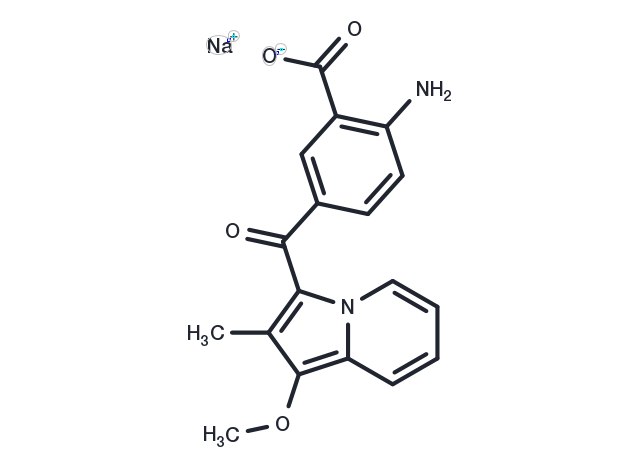Powder: -20°C for 3 years | In solvent: -80°C for 1 year


SSR128129E (SSR) is an allosteric and orally-active FGFR1 inhibitor (IC50: 1.9 μM), but not affecting other related RTKs.

| Pack Size | Availability | Price/USD | Quantity |
|---|---|---|---|
| 2 mg | In stock | $ 34.00 | |
| 5 mg | In stock | $ 55.00 | |
| 10 mg | In stock | $ 89.00 | |
| 25 mg | In stock | $ 158.00 | |
| 50 mg | In stock | $ 289.00 | |
| 100 mg | In stock | $ 455.00 | |
| 1 mL * 10 mM (in DMSO) | In stock | $ 70.00 |




| Description | SSR128129E (SSR) is an allosteric and orally-active FGFR1 inhibitor (IC50: 1.9 μM), but not affecting other related RTKs. |
| Targets&IC50 | FGFR1:1.9 μM |
| In vitro | In various murine tumor models, SSR128129E (30 mg/kg, p.o.) demonstrated the ability to inhibit both the proliferation and metastasis of primary tumors. Additionally, in mice with arthritis, SSR128129E (30 mg/kg, p.o.) reduced inflammation, angiogenesis, and bone resorption, thereby alleviating clinical symptoms. Furthermore, SSR128129E also inhibited the proliferation of both resistant and sensitive strains in models of tumors with anti-vascular endothelial growth factor receptor 2 activity, enhancing the anti-tumor activity against the vascular endothelial growth factor receptor 2. |
| In vivo | Due to its allosteric mechanism, SSR128129E exhibits enhanced activity in cell assays. It inhibits FGF2-induced proliferation and migration of endothelial cells in a dose-dependent manner, with an IC50 of 31/15.2 nM. As a multitarget fibroblast growth factor receptor (FGFR) inhibitor, SSR128129E blocks responses mediated by FGFR1-4, thus inhibiting proliferation and/or migration across various cell lines, including mPanc02, HEK-hFGFR2WT, PAE-hFGFR1, hB9-myeloma, and human umbilical vein endothelial cell lines. |
| Kinase Assay | Scintillation Proximity Assay, 125I-FGF-2 Binding: SPA protein A beads are supplied as a suspension in PBS at 20 mg/mL, then diluted with binding buffer (KCl, 400 mg/L; MgSO4 200 mg/L; NaCl 6.4 g/L; NaHCO3 3.7 g/L; NaH2PO4 0.141 mg/mL; bis Tris Propane 11.292 g/L; Glucose 4.5 g/L; Gelatin 0.1 %; pH 7.0) at 10 mg/mL. 125I-FGF-2 radioligand and FGFR-1IIIc? - Fc Chimera are diluted into binding buffer. Binding was performed on 96-well plates coated with 0.1 % gelatin. Total assay volume is 0.1 mL. Binding of 125I-FGF-2 is determined by incubation of SPA beads coated with protein A (0.5 mg/assay) with FGFR-1IIIc? - Fc chimera soluble receptor (5 ng/assay), FGF-2 (20 ng/assay) is used for non-specific binding determinations. |
| Cell Research | Cell proliferation of porcine aortic endothelial (PAE) and tumor cell lines is analyzed on exponentially growing cells that are starved for 16 hours in 0.2 % FBS containing medium and seeded at 4,000 cells/well in 96-well microplates. After exposure to mitogens and/or SSR for 72 hours, cell proliferation is assessed with the use of the CellTiter 96 AQueous One Solution Cell Proliferation Assay according to manufacturer’s instructions. 10 % FBS containing medium is used a positive control. (Only for Reference) |
| Synonyms | SSR |
| Molecular Weight | 346.31 |
| Formula | C18H15N2O4·Na |
| CAS No. | 848318-25-2 |
Powder: -20°C for 3 years | In solvent: -80°C for 1 year
Ethanol: < 1 mg/mL (insoluble or slightly soluble)
H2O: 1 mg/mL (2.88 mM)
DMSO: 64 mg/mL (184.8 mM)
You can also refer to dose conversion for different animals. More
bottom
Please see Inhibitor Handling Instructions for more frequently ask questions. Topics include: how to prepare stock solutions, how to store products, and cautions on cell-based assays & animal experiments, etc.
SSR128129E 848318-25-2 Angiogenesis Tyrosine Kinase/Adaptors FGFR SSR-128129E SSR Fibroblast growth factor receptor Inhibitor inhibit inhibitor
